4 فوائد لمكافآت الموظفين للأعمال التجارية وأمثلة على الشركات التي تنفذها
إذا لم تكن المكافآت ساحرة وليس لها صدى لدى الموظفين ، فلن تصل برامج المكافآت إلى الأرض أبدا.
في هذه الصفحة
تقول الدكتورة آشلي ويلانز، من كلية هارفارد للأعمال، بصراحة تامة: "ما يهم حقا في مكان العمل هو مساعدة الموظفين على الشعور بالتقدير والتقدير".
مع ارتباط مكافآت الموظفين وتقديرهم ارتباطا مباشرا بتعزيز الروح المعنوية وزيادة الإنتاجية وتعزيز علاقة صحية وإيجابية ، أصبح من الضروري إلى حد ما أن تثني المؤسسات على إنجازات الموظفين لتعزيز جودة الأداء ، مما يفيد في النهاية كل من الموظف والمنظمة.
وجد استطلاع حديث أجرته Great Place to Work أن 37٪ من الموظفين يعتقدون أن تقدير الموظفين هو أحد العناصر الحاسمة التي تعمل كحافز. علاوة على ذلك ، وجدت دراسة أجرتها مؤسسة غالوب أن 34٪ من الموظفين يشعرون بالمشاركة في المنظمة. وفي الوقت نفسه ، لم يحصل 65٪ من الموظفين على تقدير لعملهم الممتاز ، مما أدى إلى الإحباط. وغني عن القول أنه عندما لا يتم تقدير الناس لعملهم الشاق ، فإن ميلهم نحو أن يكونوا منتجين وإنتاج عمل جيد يأخذ المقعد الخلفي.
وضعت هذه المعضلة الشركات في وضع مكافحة الحرائق - وهذا أيضا على جبهتين:
لقد وضعت الشركات في وضع مكافحة الحرائق - وهذا أيضا على جبهتين:
- أولا ، يريدون تحفيز الموظفين على العمل بأقصى إمكاناتهم.
- ثانيا ، يريدون الاحتفاظ بكريم الموظفين.
وفي بيئة تتميز بفرص الانهيارات الجليدية للموظفين المهرة وذوي الخبرة ، يعد الاحتفاظ بالمحاصيل البشرية الموهوبة مهمة شاقة.
مما لا شك فيه أن هذا هو الوقت المناسب للاعتراف بأهمية مكافأة الموظفين ، ويبدأ بفهم ما يعنيه بالضبط.
ما هي مكافأة الموظف؟
مكافأة الموظفين هي الطرق التي تظهر بها المنظمة تقديرها لمساهمات الموظفين. وعادة ما يتخذ أشكالا عديدة وقد ينطوي أو لا ينطوي على تعويض مالي. يجب على الشركات مكافأة الموظفين على أشياء مثل:
- الانجازات
- إظهار السلوكيات المرغوبة
- تجاوز التوقعات
- معالم مثل الحيازة
لماذا مكافأة الموظف مهمة؟
1. الدافع

أغمض عينيك وتذكر أيام الدراسة عندما سلم والداك ملاحظة بقيمة 100 روبية لعلاماتك الجيدة. أو اتصل بك المعلمون أمام جميع الطلاب وأخبروا الجميع بمدى جودة مقالتك.
حقيقة أنك ما زلت تتذكره تتحدث عن القيمة العاطفية والنفسية التي تعلقها عليها. إن رغبة البشر في أن يكونوا محبوبين ومقدرين عالية جدا لدرجة أنه حتى رد الفعل المحايد عند الإنجاز الكبير يمكن اعتباره رد فعل سلبي.
نظرا لأن موظفيك يأتون من نفس الجنس البشري ، فإنهم لا يمسهم هذا الشغف البشري تماما. هناك الكثير من الدراسات لترشيدها.
سألت إحدى الدراسات الاستقصائية: "ما هو أهم شيء يفعله مديرك أو شركتك حاليا والذي من شأنه أن يجعلك تنتج عملا رائعا؟" الإجابات الناتجة في الصورة التالية.
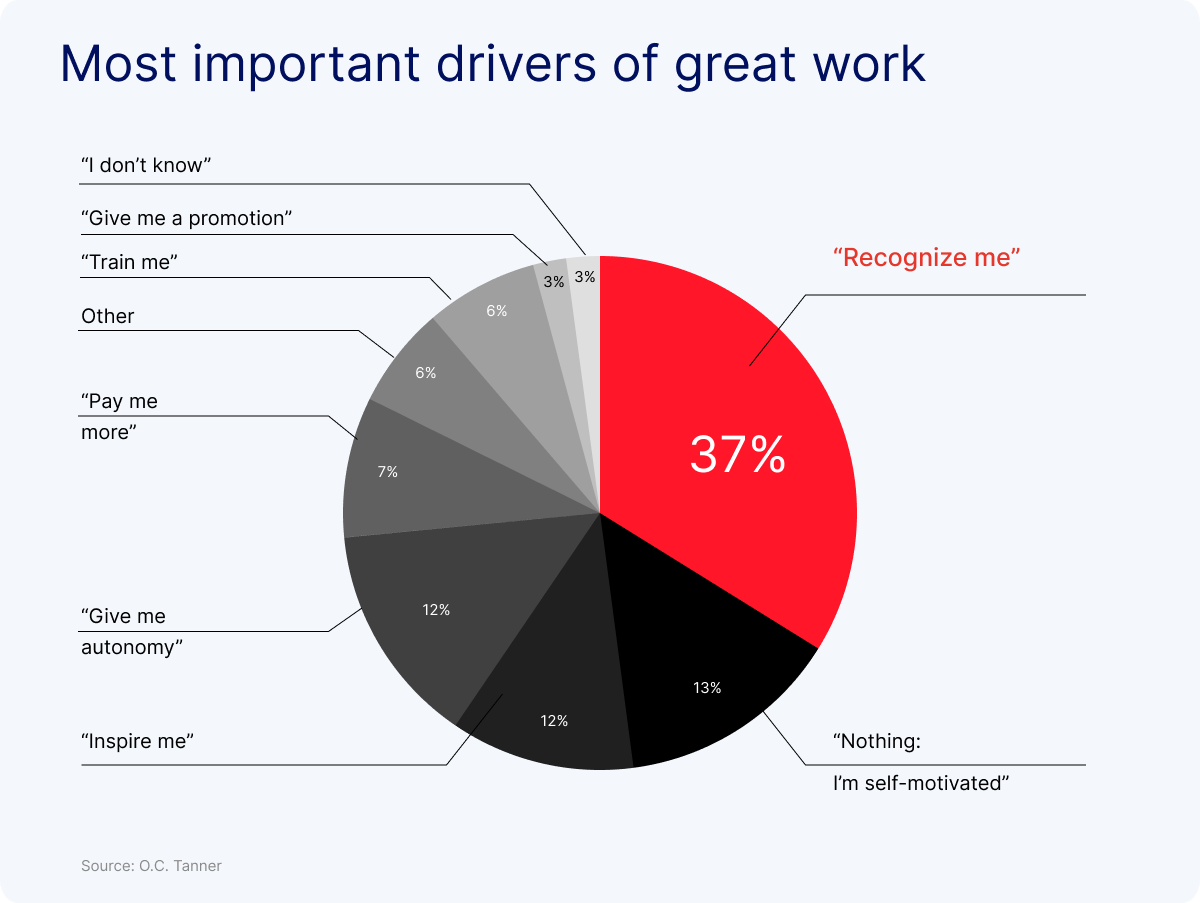
يتلاشى المال والحرية والمخاوف الأخرى ، فقط للسماح للاعتراف بالظهور كحافز واضح ومذهل. وبما أنه لا يوجد شيء يمكن أن يثبت صحة تقدير الموظف وينشره بشكل أكثر بهجة ولا تنسى من المكافآت ، فإن المكافأة هي لعبة التحفيز ما هو الوقود للمحرك.
2. الإنتاجية

عندما يكافأ الموظفون ، ينعكس ذلك في عملهم. كل من إنتاجية الموظف وأدائه أعلى بنسبة 14٪ في المؤسسات التي تمارس المكافآت بنشاط. ومما لا يثير الدهشة ، أن هناك علاقة وثيقة بين إنتاجية الموظفين وربحية المنظمة.
وفقا لشركة Bain &Company ، فإن أفضل الشركات أكثر إنتاجية بنسبة 40٪ من البقية ولديها هوامش تشغيل أعلى بنسبة 30٪ -50٪ من نظيراتها في الصناعة.
لاحظ أن ما يتم مكافأته يتكرر. يقول جميع الموظفين تقريبا إنهم أكثر عرضة لتكرار الإجراءات التي يتلقون مكافآت مقابلها. خلاصة القول هي أنه عندما تحفز الموظفين الملهمين على بذل قصارى جهدهم باستمرار من خلال المكافآت ، ترتفع الإنتاجية. يساعد هذا أيضا الفريق على تحقيق أهداف مشاركة الموظفين.
3. الرضا

لا يمكن تحقيق الرضا لدى الموظفين إلا عندما يكونون سعداء ليس فقط بالوظيفة ولكن بمكان العمل أيضًا. في هذه الحالة، يمكنك إجراء استطلاع لسعادة الموظفين لمعرفة الوضع الحالي لموظفيك. هذا العامل بالغ الأهمية، حيث أن الموظفين غير الراضين هم مجرد موظفين غير راضين عن عملهم وهم مجرد موظفين يعملون على مدار الساعة، مما يضيف عبئًا ثقيلًا وبالتالي يسلب مؤسستك الإبداع والطاقة والابتكار.
مما لا يثير الدهشة ، أن الموظفين الذين يكافأون ليسوا راضين فحسب ، بل إنهم سعداء. وهذا يعني مباشرة العملاء السعداء. لاحظت Meijer ، وهي سلسلة متاجر كبرى مملوكة لعائلة أمريكية ، أن زيادة وتيرة مكافآت الموظفين من مرتين في الشهر إلى مرتين في الأسبوع أدت إلى زيادة بنسبة 5٪ في رضا العملاء. الكتابة على الحائط واضحة: اعتني بموظفيك. سوف يعتنون بعملائك.
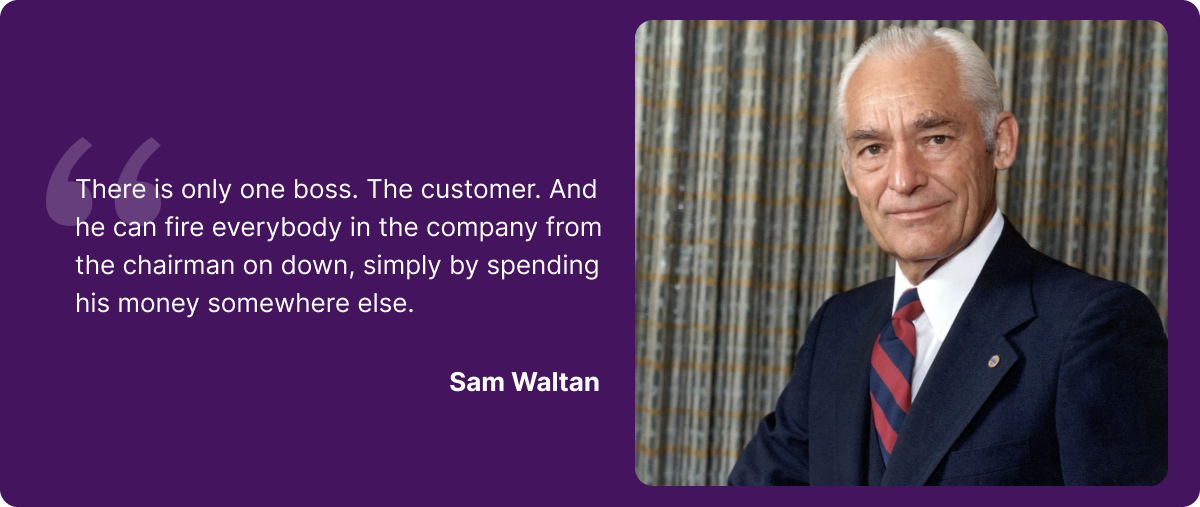
4. الاحتفاظ

بين نشر الوصف الوظيفي ، وفحص السير الذاتية ، وإجراء مقابلات مع المرشحين ، والتفاوض على الحزم ، ودفع مكافآت الإحالة أو التوقيع ، تستمر تكلفة العثور على موظف جديد في التراكم. يمكنك حساب التكلفة الأساسية ، ولكن يتم إخفاء الكثير من التكلفة المرتبطة بالدوران.
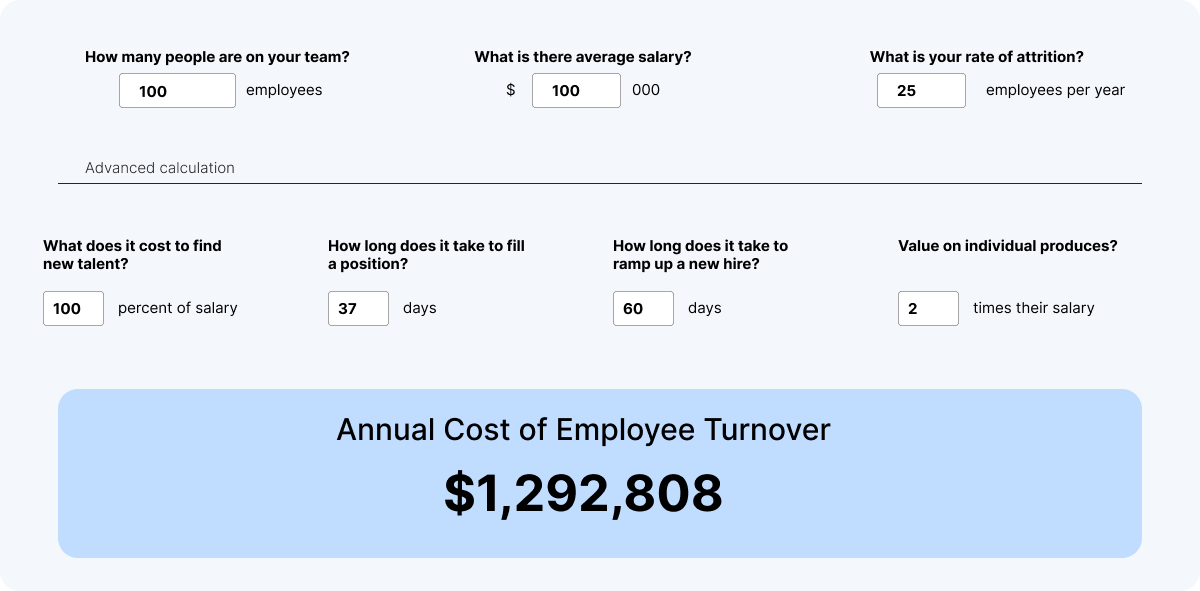
عندما يغادر الموظف ، يحتاج الفريق المعني إلى استيعاب العمل الإضافي ، مما يخلق المزيد من الموظفين غير الراضين وغير الراغبين. إنه يضر بإنتاجية وثقافة المنظمة. حتى إذا قامت المنظمة بتعيين موظف جديد ، فإنها تحتاج إلى إنفاق الوقت والمال على التدريب والتوجيه الصحيح. إنه انخفاض مضمون في الإنتاجية.
لقد أثبتت المكافأة أنها ترياق لهذا الخبث المنتشر للغاية. وجدت دراسة أجرتها Bersin and Associates أن المنظمات التي لديها برامج مكافآت لديها معدل دوران طوعي أقل بنسبة 31٪ من تلك التي لديها برامج مكافآت غير فعالة. من الواضح أن جميع الشركات ، من الشركات الكبيرة إلى المبتدئين ، تريد أن تقف عاليا في أعقاب مزايا برامج المكافآت.
فيما يلي بعض الأمثلة على أكثر الأمثلة روعة وتألقا لبرامج المكافآت:
1. زابوس
تشتهر Zappos ، وهي سلسلة تجارة إلكترونية متعددة الجنسيات ، بأخلاقيات العمل القائمة على القيمة ، وبرنامج المكافآت الخاص بها ليس استثناء منها. بالتزامن مع شعار الشركة المتمثل في "القيام بالمزيد بموارد أقل" ، يعتمد نهج مكافأة الموظفين على تنسيق نظير إلى نظير ، حيث يتقاسم الموظفون مكافآت منخفضة التكلفة وعالية التردد مع بعضهم البعض.
يكافئ الموظفين ب "دولارات زابوس" للمشاركة في التدريب ، إما كمتعلمين أو متطوعين. يمكن للموظفين استرداد هذه الدولارات في المكتب عبر آلات البيع ذات العلامات التجارية أو التبرع بها لمؤسسة خيرية شريكة ل Zappos.
ومع ذلك ، فإن ما يجعله ملفتا للنظر بشكل فريد هو أنه مصمم خصيصا وفقا لاحتياجات موقع المكتب. في مقر الشركة في لاس فيغاس ، يمكن أن يمثل امتلاك مكان لوقوف السيارات في ساعات الصباح المزدحمة تحديا حقيقيا. مرة واحدة في الأسبوع ، يسمح للموظفين بترشيح زميل لمكان خاص لوقوف السيارات يعتبر "مكافأة".
2. أبل
هناك سبب وراء تسمية شركة Indeed لشركة Apple كأفضل صاحب عمل في القطاع الخاص في المملكة المتحدة ، وصنفتها LinkedIn في المرتبة السادسة كأفضل شركة للعمل بها في الولايات المتحدة. تم تشكيل جوهرها من خلال برامج مكافآت وتقدير موظفيها المدروسة والإنسانية والمبدعة.
أحد الأمثلة على ذلك هو موسم العطلات. فاجأت Apple موظفيها بعطلة ممتدة حتى تتمكن القوى العاملة بأكملها من أخذ استراحة لمدة أسبوع. بدلا من يوم عطلة واحد فقط في عيد الشكر ، قررت Apple تقديم إجازات مدفوعة الأجر لمدة ثلاثة أيام متتالية.
ومع ذلك ، حولت Apple هذه الميزة التي تبدو بسيطة إلى مكافآت من خلال تخصيصها وفقا لموقع الموظف ودوره الوظيفي. سيحصل الموظفون الذين يتصببون عرقا في أجزاء مختلفة من العالم على إجازة مدفوعة الأجر خلال عطلة مماثلة. سيحصل عمال التجزئة الذين يبذلون جهودا إضافية خلال موسم العطلات على مكافأة مماثلة في وقت بديل.
3. هيوليت باكارد
تشتهر شركة تكنولوجيا المعلومات العملاقة ، المعروفة باختصارها HP ، بمكافأة الموظفين والشركاء بطرق متطورة ومبتكرة ، ومشروع Everest هو مثال رئيسي على ذلك. في نظام المكافآت المحفز هذا ، يتم تمثيل بائعي المنتجات من خلال صورة رمزية تتسلق جبلا.
في كل مرة يشير فيها مندوب مبيعات إلى إنجاز مبيعات متألق ، ستتحرك الصورة الرمزية إلى أعلى الجبل. تمكن أفضل أداء من الفوز بأجهزة التلفزيون والأجهزة اللوحية وهم يشقون طريقهم إلى أعلى الجبل. كانت الجائزة الكبرى عطلة العمر.
لقد كان نجاحا هائلا في اثنين من أهم معايير أي برنامج مكافآت: المشاركة وزيادة الإيرادات النهائية.
ومع مشاركة أكثر من 80% من جميع بائعي هيوليت باكارد في المشروع وزيادة إيرادات المبيعات بنسبة 56.4%، فقد بدد كل الشكوك حول كفاءة نظام المكافآت، خاصة في شكله المتطور القائم على الألعاب، لإشعال مسار المبيعات بشكل غير مسبوق.
4. دايركت في
لا يجب أن تحتفل المكافآت دائما بالنجاح. يمكن استخدامها بشكل فعال للتعلم من الإخفاقات والتحايل على نقاط الزناد لتلك الإخفاقات. يعد F12 من DirecTV مثالا ملتهبا يتم وضعه في قفص في هذه الفئة.
بعد فشل مشروع تكنولوجيا المعلومات للمرة الثانية خلال 12 شهرا ، قررت DirecTV إعادة تعريف فكرة الفشل من خلال إنشاء منصة تعليمية محببة للسماح لقسم تكنولوجيا المعلومات بإنشاء وعرض مقاطع الفيديو الخاصة بهم حول الفشل.
أطلق عليه اسم "F-12" للإشارة إلى "برنامج الشركة المكون من 12 خطوة للتغلب على الفشل" ، وسمح للموظفين بالوصول إلى منصة التعلم وإكمال المهام لعرض أو إنشاء مقاطع فيديو ، وإجراء اختبارات ، ومشاركة مقاطع الفيديو أو التعليق عليها.
يضمن البرنامج حصول الموظفين على نقاط وشارات لهذه المشاركة النشطة. حصل أصحاب الأداء الأفضل لكل ربع سنة على جوائز مثل أجهزة iPad و iPod.
نظرا لأن فكرة F-12 كانت تجعل الموظفين يتقبلون الفشل بدلا من الشعور بالحرج منه ، فإن ذلك لم يغير فقط طريقة تفكيرهم حول الكلمة المخيفة التي تسمى الفشل. لقد جعلهم أكثر استباقية وقوة عقلية بما يكفي للتغلب على أخطاء الماضي.
وانعكس ذلك في الأرقام: تضاعف نشاط المستخدم على المنصة ثلاث مرات ، وأنشأ الموظفون أكثر من 100 مقطع فيديو ، وشهدت تكنولوجيا المعلومات انخفاضا بنسبة 30٪ في مشاكل نشر تكنولوجيا المعلومات. بالإضافة إلى ذلك ، أطلقت تكنولوجيا المعلومات بنجاح أول مشروع مؤسسة خالية من العيوب.
5. سكوبلي
تكافئ شركة ألعاب الفيديو هذه بشكل رائع فنانيها المنشقين على الإنجازات بالجوائز والصراخ على الشبكات الاجتماعية والمكافأة. لكنهم سرعان ما أدركوا أهمية تحويل هذا العمل المجزي لمرة واحدة إلى ثقافة الشركة من خلال إبقائها على قيد الحياة على مدار العام.
الحقيقة هي أنه للحفاظ على عجلات الشركة في حالة حركة ، فأنت تريد أن تكرر قبعاتك نفس الأداء في العام المقبل أيضا.
وهذا يفسر سبب ذهابهم إلى أبعد من ذلك - خاصة لمكافأة الموظف في ذكرى عمله. تخلد الشركة الموظفين في لوحة زيتية. وتشمل الهدايا الأخرى سيوف الساموراي المصنوعة حسب الطلب.
إنه ذكاء تكتيكي لأنه يمنح الموظفين مكافأة شخصية لن ينسوها أبدا ويفعل ذلك في الوقت الذي يكون فيه الأشخاص أكثر عرضة إحصائيا لتغيير وظائفهم: الذكرى السنوية الأولى لعملهم.
6. بروبلرنت
كانت كرات أحلام Propellernet حديثا عن المدينة لفترة طويلة جدا ، وهي تستحق بحق هذا النوع من الاهتمام المستمر. إنه يحقق بلا خطأ روح وقلب أي برنامج مكافآت للموظفين: رضا أعمق للموظفين.
يضيف كل موظف "كرة الأحلام" (التي تشير إلى حلم) إلى آلة الأحلام الخاصة بالشركة. عندما تحقق Propellernet بعض الإنجازات المتألقة ، والتي تعتقد أنها ترجع إلى موظفيها القادرين ، تتم إزالة الكرة ، ويسعد Propellernet الموظف بجعل حلمه حقيقة. حتى الآن ، منحوا أمنية في رحلة ملحمية عبر إفريقيا وتنظيم أوبرا روك خيال علمي.
مع وضع 5٪ من الأرباح في "صندوق المرح" لأنشطة الأحلام الأخرى مثل رحلات الحانة وأنشطة العافية مثل جلسات الوساطة ، فليس من المستغرب أن يتم التصويت على الشركة كواحدة من أفضل أماكن العمل في المملكة المتحدة.
7. الأمازون
أدركت أمازون ، كتلة التجارة الإلكترونية ، الحاجة إلى مكافآت غير نقدية لزيادة كفاءة الموظفين ، وبالتالي الإنتاجية. من خلال برنامج المكافآت المسمى FC Games ، حولت مهام المستودعات إلى ألعاب فيديو على غرار ألعاب الأركيد.
الهدف هو مكافأة الموظفين على أشياء مثل السرعة - وهو أمر بالغ الأهمية للمؤسسات التي تركز على التسليم مثل Amazon. يتم ترجمة عروض "الألعاب" هذه أو الساعات الإضافية إلى عملة أمازون الخاصة ، والتي يمكن للموظفين استبدالها بأشياء مثل القمصان وزجاجات المياه.
خلال ذروة العطلة ، تقدم أمازون المزيد من العناصر ذات التذاكر الكبيرة مثل وحدات التحكم في الألعاب والساعات الذكية. بالنظر إلى الاستجابة الكبيرة التي حصلت عليها ، تقوم أمازون الآن بتوسيع البرنامج ليشمل مرافق في 20 ولاية.
8. مارس
من خلال تجاوز الإجازة المدفوعة الأجر إلى التطوع وإجازة الأبوة ، بالإضافة إلى خطة مطابقة ضخمة تبلغ 401 ألف ، لا يدخر منظرو MARS أي جهد في إظهار مدى اهتمامهم بالرفاهية الشاملة لموظفيهم.
إن الإيمان القوي بالحفاظ على شركائهم "متحمسين ومنتجين وسعداء وصحيين ليس مهما فحسب - بل إنه ضروري" ، فهم يكافئون موظفيهم بالعافية من خلال إدارة الإجهاد والتغذية والنشاط البدني والإقلاع عن التبغ وإدارة الوزن والرعاية الطبية في الموقع.
نظرا لأن العافية والصحة هما الدعامة الأساسية لنظام المكافآت الخاص بهم ، فمن المنطقي سبب منح MARS أول "جائزة العافية في مكان العمل" الذهبية من قبل مجالس أماكن العمل الأمريكية.
بالطبع ، الاستشهادات المذكورة أعلاه هي غيض من فيض ، حيث أن عالم الأعمال مليء بعدد لا يحصى من برامج المكافآت التي أصبحت حقا أضواء إرشادية - فقط لإثبات أن تشغيل برنامج مكافآت ناجح ليس علم الصواريخ.
مثل كل الأشياء الأساسية في الحياة ، يجب أن يتم تهنئتها بعناية ويجب أن تمر عبر عمليات عقلية وعملية لا مفر منها ، مثل:
- ✅ فضح الخرافات حول برامج المكافآت
- ✅ وضع العمود الفقري الأيديولوجي والوظيفي للبرامج
- ✅ تنفيذها بأقصى درجات الدقة
دعنا نتعمق في كل جزء.
أ. الخرافات حول برامج المكافآت
على الرغم من تنفيذها من قبل جميع الشركات الكبرى التي عرفتها البشرية على الإطلاق ، وأثبتت أنها رصاصة فضية في الاحتفاظ بالموظفين وزيادة الإنتاجية ، إلا أن قلة من قادة الأعمال لا يزالون يحملون شكوكا عميقة حول فعالية برامج المكافآت.
عادة ما ينبع دائما من الأساطير ، والتي هي في وفرة. يعد فضحها ذا أهمية حيوية قبل أن تتمكن من البدء في بناء برنامج مكافآت مزدهر.
1. المال فقط يمكن أن يحفز الموظفين

لا يزال العديد من قادة الأعمال مدفونين تحت فكرة أن الموظفين يعملون فقط من أجل المال ، مما يجعل برامج المكافآت مضيعة للوقت والمال - وهما من أكبر الموارد في العصر الحديث.
تظهر الأبحاث أن القادة لا يمكن أن يكونوا أكثر خطأ في افتراضاتهم. أظهرت دراسة أجريت على الموظفين الذين تركوا الشركة طواعية أن 79٪ غادروا ليس من أجل المزيد من المال ولكن لأنهم لم يشعروا بالتقدير والمكافأة.
لها دلالات نفسية أيضا. بمجرد تلبية الاحتياجات الأساسية للبشر ، فإنهم يتطلعون إلى أشياء أعلى في الحياة - وعادة ما يتصدر الاحترام والتقدير بين الزملاء والعائلة القائمة. في الواقع ، وجدت دراسة أن مندوبي مبيعات البرمجيات كانوا سعداء بالتخلي عن ما يقرب من 30000 دولار من المكافآت لنجمة ذهبية على بطاقة أعمالهم ، مما يشير إلى أنهم صنعوا "نادي الرئيس".
الكتابة على الحائط ، إذن ، واضحة. المال شيء ولكن ليس كل شيء ، مما يسلط الضوء بشكل لا لبس فيه على الحاجة إلى مكافأة الموظفين عند استحقاقها.
2. برامج المكافآت تأكل وقتك

نظرا لأن المديرين والمديرين التنفيذيين يعانون دائما من ضيق الوقت ، فإنهم يعتقدون أن تشغيل وإدارة برامج المكافآت سيخنق قسم الإدارة بمتطلبات الوقت. أضف إلى ذلك حدودهم الزمنية الخاصة - وهم يعتقدون أنهم لا يستطيعون المشاركة فيها ، مما يجبر برامج المكافآت على الذهاب إلى الموقد الخلفي.
محركات المكافآت الحديثة مثل Plum أكثر من مجهزة لوقف هذه المخاوف ، لأنها ولدت بهذه النية في المقام الأول.
من خلال عمليات تكامل واجهة برمجة التطبيقات التي لا تعد ولا تحصى ، وحيادية النظام الأساسي ، والتشغيل متعدد اللغات ، ومجموعة متنوعة مذهلة من المكافآت ، وميزة المكافآت المدفوعة فقط مقابل الاسترداد ، فإنها لا تجعل إرسال المكافآت واستلامها أمرا بسيطا مثل إرسال رسائل البريد الإلكتروني وبالتالي توفير الوقت.
ولكن من خلال إخراج الخدمات اللوجستية والهدر من المعادلة ، فإنه يلغي النفقات الإدارية العامة أيضا. وبالتالي ، فإنه يجعل مكافأة إجراء منخفض التكلفة وعالي التأثير.
3. برامج المكافآت لها عائد استثمار غير موثوق به

أحد الأسباب الرئيسية لعدم قدرة القادة على التكيف مع برامج المكافآت هو أنه لا يمكن تحديد عائد الاستثمار لبرامج المكافآت.
ومع ذلك ، لا توجد ندرة في الدراسات التي تبرز أهمية المكافآت والتقدير في توليد أجواء إيجابية بين الموظفين وترجمتها إلى مكاسب أساسية للشركات.
أظهرت إحدى الدراسات أن تعبيرا بسيطا عن الشكر من قبل شخص في السلطة أدى إلى أن يكون الناس أكثر إنتاجية بنسبة 50٪!
علاوة على ذلك ، يشير تقرير غالوب إلى أن الفرق المشاركة تشهد انخفاضا بنسبة 40٪ في معدل الدوران الطوعي. تثبت هذه الإحصاءات أن العائد على الاستثمار في الاعتراف يمكن التنبؤ به أكثر مما يفترض القادة.
الحقيقة هي أن عائد الاستثمار للمكافأة قد لا يكون شيئا فوريا. تستغرق ثقافة المكافآت وقتا لتزدهر في التربة التنظيمية. ولكن عندما تزهر تماما ، يكون لها آثار زلزالية عالية على معنويات الموظفين وإنتاجيتهم والاحتفاظ بهم.
4. المكافأة هي IOU
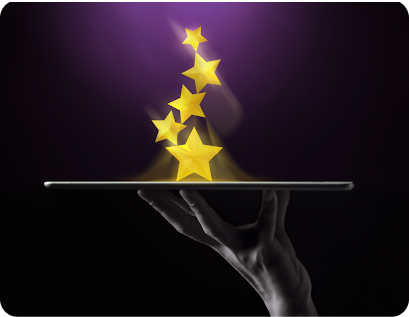
على الرغم من أن المكافآت يمكن أن تصل إلى المحصلة النهائية كما لم يحدث من قبل ، إلا أن هذا ليس الغرض الوحيد من مكافأة موظفيك. لا ينبغي النظر إليه على أنه IOU فقط.
أوضح عالم النفس بول وايت في كتابه الشهير عن المكافآت أنه عندما يعتقد الموظفون أن الإدارة تستخدم الاعتراف فقط كأداة لزيادة الإنتاجية والأرباح ، فإنها تنتج عدم الثقة. وبالتالي ، يتم تبادل كلمات الثناء الضحلة كرمز للفتة ، مما يجعل المكافآت تبدو عامة ومزيفة. بطبيعة الحال ، فإنه يقوض نشأة البرنامج بالكامل. خلاصة القول هي أن القادة سوف يستفيدون من الفوائد الملموسة للمكافآت إذا اعتقد الموظفون أن الثناء حقيقي وصادق.
إن فضح هذه الأساطير أمر بالغ الأهمية ، لأن أولئك الذين يؤمنون حقا بقوة المكافآت هم وحدهم الذين يمكنهم أن ينبتوا برنامج مكافآت جيد التخطيط وكامل. بمجرد أن يكون لدينا مؤمنون على متن الطائرة ، يمكننا المضي قدما إلى مرحلتنا التالية.
ب. وضع العمود الفقري الأيديولوجي والوظيفي للبرامج
تبدأ كل استراتيجية رائعة بأساس قوي - وبرامج المكافآت لا تبتعد عنها. قبل الالتزام بأي شيء ، يجب أن تفهم أساسيات المكافأة: ما الذي يجب مكافأته ، ومن تكافئه وما هي الخصائص الأساسية للمكافآت. على نطاق واسع ، ينقسم إلى أربع فئات -
1. خلق حالة للمكافآت

بادئ ذي بدء ، ابدأ بإنشاء حالة عمل لبرنامج مكافآت الموظفين ، ولا تنس ربطه بنتائج عملك المرجوة. ضع قائمة بكيفية مساهمة مكافأة الموظفين في تحقيق أهداف العمل. أقنع قيادتك بأن الفوائد تفوق التكاليف.
دع قيادتك تفهم التكاليف الخفية والخدمات اللوجستية للبرامج اليدوية. قد يبدو الذهاب إلى المتاجر في كل مرة لشراء بطاقات هدايا لفريقك المكون من خمسة أفراد وملاحظات مكتوبة بخط اليد لكل شخص أمرا بسيطا نسبيا ويمكن التحكم فيه للبدء.
ولكن عندما ينمو فريقك بشكل كبير ، تصبح هذه البرامج اليدوية غير عملية ، وتتطلب مستوى جديدا تماما من التخطيط والإشراف والاتساق. لحسن الحظ ، يمكن أن تتكامل منصات المكافآت والتقدير مع الأدوات الحالية ، وأتمتة الوفاء بالمكافآت ، وإدارة المكافآت بكفاءة.
2. بناء فريق من المتحمسين

بمجرد حصولك على الضوء الأخضر من الإدارة ، يجب أن تشارك في بناء فريق يبحر في برنامج المكافآت الخاص بك.
اختر الأشخاص الذين سيساعدون في وضع تصور لبرنامج المكافآت الجديد لمؤسستك والترويج له والتواصل معه وتنفيذه وتعزيزه. يجب عليهم تحديد مربعات الاختيار التالية للخصائص:
- مهتم للغاية بالبرنامج
- الإيمان بفوائد البرنامج
- لديهم معرفة بمعرفة المكافآت
- القدرة على تحديد أولويات البرنامج وتعديله حسب الحاجة
- ثبت سادة مهمة عاطفي
3. فهم خصائص المكافآت الفعالة

قبل الانتقال إلى أي برنامج مكافآت ، من الضروري أن يفهم جميع المعنيين الخصائص الأساسية للمكافآت الفعالة:
- الوقت المناسب: المكافآت فعالة حقا فقط عندما تعطى في الوقت المناسب. لاحظ أن الارتباط بين المساهمة والمكافآت يضعف بمرور الوقت. لذلك ، يجب أن يكون الهدف هو إعطاء المكافآت في أقرب وقت ممكن عندما يكون السبب موجودا.
- مُتَكَرِّر: من الخطأ انتظار أكبر وأروع الإنجازات لمكافأة الموظفين. الحقيقة هي أنهم يساهمون يوميا والفشل في الاعتراف بذلك بانتظام يجعلهم يشعرون بأقل من قيمتها في الشركة. لاحظ أن 71٪ من الموظفين المتفاعلين للغاية يعملون في مؤسسات تعترف بالموظفين مرة واحدة على الأقل شهريا.
- خاص: يجب أن تكون المكافآت محددة ، لأنها تساعد الموظفين على معرفة أي من أفعالهم ساعدت بالضبط هدف فريقهم. أيضا ، تعني المكافآت المحددة الاعتراف بتفاصيل المهام وسياقها ، وليس مجرد "شكر" بارد وروتيني. في النهاية ، لا يأتي مع خطر الظهور على أنه غير صادق أو غير واضح.
- ظاهر: الاعتراف الخاص أمر رائع ، لكن مكافأة الموظف علنا تفعل العجائب. نظرا لأن كل شخص في المنظمة يعرف أن عملك الشاق موضع تقدير ، فإنه يضخم تأثير التقدير. إنه يغرس عامل الشعور بالرضا بين الموظفين من خلال كسب الاحترام في عيون الأقران. ليس من المستغرب إذن أن تتصدر مكافأة الجمهور من خلال جائزة أو شهادة قائمة تفضيلات الموظفين في استطلاع غالوب لمكان العمل.
- على أساس القيمة: نظرا لأنه من الإيمان أن موظفيك يعملون من أجل رؤية وقيم مشتركة ، فإن مكافأة موظفيك على تعزيز هذه القيم يجب أن تجد جذورا عميقة في مؤسستك. إذا كان كونك إنسانيا هو المبدأ التوجيهي لخدمة العملاء الخاصة بك ، فإن مكافأة الموظف الذي قطع شوطا إضافيا في هذا الاتجاه يجب أن يكون مرشحا مستحقا في برنامج المكافآت الخاص بك - وليس فقط الشخص الذي تعامل مع المزيد من استفسارات العملاء.
باختصار ، عندما تكافئ موظفيك ، ضع في اعتبارك PEP ، الاختصار ، للحصول على النشاط بشكل مثالي.
- شخصي- يجب أن تسلط المكافآت الضوء على الشخصية أو الشخصية أو المهارات الفريدة لموظفيك. تتعرض المكافآت غير الشخصية لخطر النسيان بسهولة.
- مكسوب- يجب أن تستند المكافآت إلى الجدارة. لا ينبغي أن تكون المكافآت الشخصية بالضرورة لإنجاز المهام اليومية. يجب مكافأة أي موظف يتجاوز الواجبات المحددة.
- عملية- اسأل نفسك ما الذي فعله الموظف المستحق بشكل مختلف في هذه العملية. ما هي مساهمته الفريدة؟ ما هي المعرفة أو المهارة أو الموهبة التي طبقها؟
ج. تنفيذ البرامج بأقصى درجات الدقة
بمجرد تسييج أسس برنامج المكافآت ، فإن التقدم الطبيعي يدخل في واقع التنفيذ.
1. تحديد الأهداف الصحيحة

يجب أن يبدأ التنفيذ بوضوح مرتب حول الغرض من رغبتك في مكافأة موظفيك. باختصار ، يجب عليك تحديد الأهداف بأكبر قدر ممكن من الوضوح بطريقة يمكن فهمها من قبل القيادة والإدارة ومستخدمي البرنامج.
إنه يحمل مفتاح نجاح برنامج المكافآت الخاص بك ، حيث يقرر الشكل وإعادة الشكل الذي سيتخذه طوال الدورة.
تأكد من أن أهدافك يجب أن تتوافق بشكل متوافق مع رسالتك ورؤيتك. يجب عليك أيضا التفكير في محركات الأعمال التي يحاول برنامجك التأثير عليها؟ (مشاركة الموظفين ، والاحتفاظ بهم ، والمواءمة ، والأداء ، والقيم / القيادة القائمة على السلوك ، وما إلى ذلك)
لمساعدتك في التركيز على الأهداف الصحيحة ، قمنا بإدراج الأهداف التي يجب التفكير فيها لبرنامجك.
- لتحسين مشاركة الموظفين.
- خلق وغرس ثقافة الاعتراف.
- لدمج جميع برامج الاعتراف في استراتيجية واحدة شاملة مركزة.
- لمواءمة الموظفين مع رسالتك وأهدافك وقيمك.
- التعرف على السلوكيات المرغوبة وتعزيزها.
- التعرف على نتائج الأداء المرجوة ودفعها.
- تحفيز الأداء الفردي والجماعي، للتأثير بشكل إيجابي على أداء الموظفين.
2. ترجمة أهدافك إلى أهداف ذات مغزى

يجب أن تعرف في أي نقطة يمكنك استدعاء برنامج المكافآت الخاص بك بنجاح. والطريقة الوحيدة لتحديده هي وضع تدابير وأهداف (مع تواريخ مستهدفة) لكل هدف والتمييز بوضوح بين التدابير النوعية والكمية .
يمكنك تصميم "بطاقة أداء" للبرنامج مع مقاييس واضحة لتحديد نجاح برنامجك في أي وقت.
إليك كيف يمكنك ربط أهدافك بالأهداف.
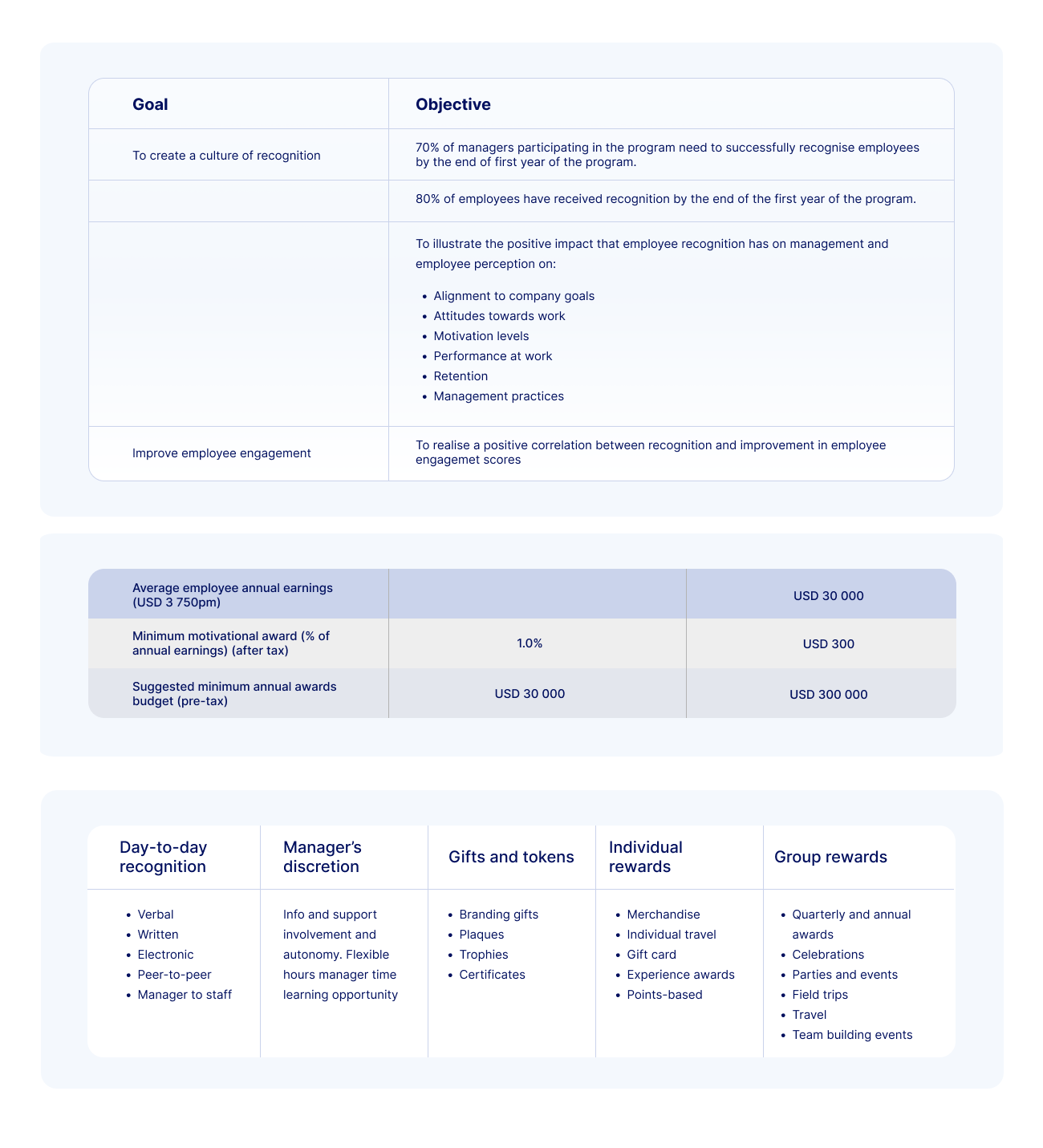
3. تحديد وتعريف المشاركين في البرنامج الخاص بك

يجب تحديد "من" البرنامج في وقت مبكر جدا: من يحتاج إلى مكافأة ومن هو المؤهل لذلك. باختصار ، إنه فصل القشر عن الحبوب. يمكن تقطيرها من خلال تحقيق شامل باستخدام الأسئلة التالية -
- من يجب أن يشارك في البرنامج لتحقيق أهدافك الاستراتيجية؟ يختلف بشكل عام وفقا لأهدافك.
- هل تخطط له كبرنامج على مستوى المؤسسة ، أم أنه لقسم معين من عملك؟
- هل يجب استبعاد بعض الموظفين؟ على سبيل المثال ، هل يجب تضمين أو استبعاد الموظفين الموقوفين أو الموظفين في فترة إشعار أو الموظفين الذين يخضعون لإجراءات تأديبية أو المستقلين؟
- هل هناك أي قيود فيما يتعلق بمن يمكنه كسب مكافآت ملموسة؟ تستبعد بعض الشركات مستويات معينة من الإدارة من مكافآت محددة.
- عندما يكون اقتصاد العربة في أعلى مستوياته على الإطلاق ، من المهم أن تقرر ما إذا كان ينبغي مكافأة الموظفين غير الدائمين أم لا.
4. إصلاح فترة البرنامج الخاص بك

كما ذكرت سابقا أيضا ، فإن المكافأة هي عملية تستمر مدى الحياة - وتستغرق وقتا حتى تتجذر في مؤسستك. تشير الأبحاث إلى أن الأمر يتطلب 3 سنوات حتى تصبح أي مبادرة مكافآت ميسرا رئيسيا للتغيير الذي ترغب في رؤيته. هذا هو المكان الذي يحتاج فيه برنامجك إلى أن يكون مرنا بما يكفي للتكيف مع الاحتياجات المتغيرة لاتجاهات الوقت والمكافآت.
5. تحديد الميزانية
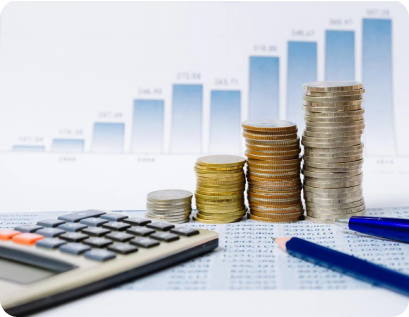
نظرا لأنه يمكن أن يصنع أو يكسر ليس فقط نجاح البرنامج ولكن العمود الفقري الاقتصادي للمنظمة بأكملها ، يجب أن يتم ذلك بحكمة. المشكلة هي أن الشركات المختلفة لديها عضلات نقدية مختلفة ، مما يستبعد نهج الحجم الواحد. ومع ذلك ، يجب اتباع بعض المعايير أثناء تحديد الميزانية النهائية.
وفقا لبحث أجرته WorldAtWork في اتجاهات 2017 في التعرف على الموظفين اقترح الإحصائيات التالية:
- المتوسط هو 2٪ من كشوف المرتبات
- متوسط الميزانية هو 1٪
- الوضع (الاستجابة الأكثر شيوعا) هو أيضا 1٪
نوصي بما بين 1٪ و 2٪ من كشوف المرتبات إذا تم تضمين المكافآت الخارجية. ومع ذلك ، إذا تم تنفيذ المكافآت الجوهرية أو أساليب مكافأة المنافسة (عدد محدود من الفائزين مقابل كل شخص لديه فرصة للمكافأة) ، فيمكن تقليص الميزانية إلى 0.75٪ من كشوف المرتبات.
يجب أن يكون مفهوما أن برامج المكافآت تستغرق بعض الوقت لتصبح مدمجة بالكامل في الشركة ، ويمكن أن يكون استيعاب الميزانية بضع سنوات. لهذا السبب لا ينبغي أن تستند ميزانيات السنوات اللاحقة بالكامل إلى القيم الفعلية للعام السابق ، حيث يجب أن يزداد الاستيعاب كل عام.
من الواضح أن تحديد استثمارك في برنامج مكافآت الموظفين متغير لأن احتياجات كل شركة مختلفة. لتوضيح كيف يمكن للشركات التعامل مع الميزانية ، سيكون على السطر التالي:
إنه أحد الأسباب الرئيسية التي تجعل الشركات الأمريكية تستفيد من المكافآت غير النقدية لدعم برامج مكافآت موظفيها. كما أظهرت دراسة توقعات IRF لعام 2018 أن 43٪ من المستجيبين يستثمرون ما يقدر بنحو 250 دولارا أمريكيا لكل موظف.
لهذا السبب للحفاظ على ثقافة المكافآت دون مساومة على مدار العام ، يمكنك التفكير في المزيج الصحيح من المكافآت الجوهرية والخارجية.
6. امنح موظفيك صوتا

إذا لم تكن المكافآت ساحرة وليس لها صدى لدى الموظفين ، فلن تصل برامج المكافآت إلى الأرض أبدا. لهذا السبب يجب ألا تتجاهل أبدا إجراء الاستطلاعات لمعرفة المكافآت التي تحتل مرتبة عالية في قائمة رغبات موظفيك.
لاحظ أن إعطاء الموظفين رأيا في استرداد المكافآت يزيد من اهتمامهم الشخصي بالبرنامج ويجعل المكافآت أكثر متعة ومرضية.
يمكن أن تكون بطاقات الهدايا مفيدة جدا في هذا الصدد ، لأنها تمنح الموظفين حرية اختيار ما يريدون ومتى يريدون.
7. رؤية برنامج المكافآت الخاص بك بشكل فعال

إذا كان بعيدا عن الأنظار ، فهو بعيد عن العقل. تذكر هذا المبدأ ولا تدخر جهدا في ضمان أن الموظفين في جميع الملفات والرتب على دراية جيدة ببرنامج المكافآت الخاص بك. والمفتاح لذلك هو التواصل الفعال عبر جميع قنوات الاتصال المفضلة.
من الضروري أن نفهم أن هناك أنواعا مختلفة من القوى العاملة ولديهم طرق الاتصال المفضلة لديهم. على سبيل المثال ، قد يجد موظفو المصنع الأكشاك المتخصصة كأفضل أداة للحصول على التحديثات الرئيسية ، بينما قد يفضل الموظفون الإداريون البريد الإلكتروني.
8. قياس فعالية برنامجك

برنامج المكافآت الذي يتم تنفيذه جيدا هو عامل تمكين متعدد الجوانب يؤثر بشكل إيجابي على الأداء والإنتاجية ومعدل الدوران. يمكنك التدقيق فيه من خلال أدوات المسح وجلسات التغذية الراجعة وبرامج إدارة الأداء ومعرفة مدى قربك أو بعدك عن الأهداف المرجوة لأهداف برنامجك.
ومع ذلك ، يمكنك تسخير البيانات التي تم جمعها جيدا باستخدامها لقرارات العمل الأخرى. يمكنك معرفة الفرق الموجودة في صوامع ، والموظفين الذين يحتاجون إلى تعزيز التحفيز ، وما هو السبب وراء عدم مشاركة بعض الموظفين.
سيساعدك هذا النهج الشامل تجاه برنامج المكافآت على بناء قوة عاملة أكثر تماسكا وإلهاما ، وهي شريان الحياة لأي مؤسسة.
9. مراجعة وإحياء بانتظام

لا يوجد شيء مثالي ، وبرنامج المكافآت الخاص بك ليس استثناء من هذه الحقيقة البديهية. بغض النظر عن البحث الذي تجريه وتجعله ينبض بالحياة من خلال التخطيط الدقيق ، لا يمكن لبرنامج المكافآت إرضاء جميع الموظفين.
سيسعى عدد قليل منهم للحصول على المكافآت غير المثيرة ، بينما قد يشتكي البعض الآخر من معايير المكافآت. أكثر ما يمكنك فعله هو الاستمرار في برنامج مرغوب فيه لغالبية الموظفين.
هذا هو المكان الذي سيساعدك فيه تلقي تعليقات منتظمة من الموظفين على تحديد القيمة التي يحملها برنامج المكافآت الخاص بك في أعينهم. ستتيح لك ملاحظات القيادة معرفة ما إذا كان البرنامج يؤثر على الأداء الوظيفي ونتائج الأعمال بطريقة مخططة أم لا.
بمجرد أن تكون مجهزا بهذه الأفكار ، يمكنك إجراء تعديلات كلما كانت مرغوبة وممكنة. اكتشف وقت المسؤول والتكلفة التي ستحتاجها. هذه المرحلة بالغة الأهمية لنجاح برنامج المكافآت الخاص بك على المدى الطويل - خاصة عندما يتضح لك أن كل مؤسسة مختلفة ويجب أن تكون برامج المكافآت مصممة لتناسب هذا الاختلاف.
كيف يمكن لعمليات تكامل واجهة برمجة التطبيقات شحن نظام إدارة الموارد البشرية (HRMS) لمكافأة الموظفين
"تكامل واجهة برمجة التطبيقات." يجب أن تكون قد سمعت عنها عدة مرات عند البحث عن نظام إدارة الموارد البشرية (HRMS) جيد.
باختصار ، تعمل واجهة برمجة التطبيقات مثل "رسول" يساعد:
↠ تسليم طلباتك إلى مزود
↠ يرسل الردود إليك مرة أخرى
عندما يقوم المبرمجون بإنشاء التعليمات البرمجية ، فإنهم لا يفعلون ذلك من البداية. بدلا من ذلك ، يستفيدون من واجهات برمجة التطبيقات لمساعدتهم على كتابة التعليمات البرمجية باستخدام أطر عمل موجودة مسبقا وضمان مقترحات فريدة للتطبيقات. يمنع الحاجة إلى إعادة اختراع العجلة في كل مرة يكتبون فيها برنامجا جديدا.
تمكن واجهات برمجة التطبيقات المطورين من إنشاء حلول توفر تجارب عملاء رائعة دون إضافة تكلفة للشركات. بالإضافة إلى ذلك ، فهي تساعد في تبسيط العمليات التجارية بشكل أكثر فعالية وسلاسة. تعد عمليات تكامل واجهة برمجة التطبيقات ضرورية ، خاصة للشركات التي تتعامل مع العديد من التطبيقات والأدوات المستندة إلى السحابة.
عند الحديث عن نظام إدارة الموارد البشرية على وجه التحديد ، فإن تكامل واجهة برمجة التطبيقات هو شيء يتوق إليه كل مدير ومطور للموارد البشرية. اكتسبت بساطتها وسهولة استخدامها شعبية كبيرة على مر السنين لدرجة أن معظم الشركات التي تتطلع إلى تنفيذ حلول HRMS المحتملة في مؤسساتها تبقي "عمليات التكامل" في طليعة مناقشاتها.
واجهات برمجة التطبيقات أو تطبيقات الجهات الخارجية هي فقط ما تحتاجه الشركة لتعزيز إمكانات النظام الأساسي. يمكن أن يؤدي اختيار نظام إدارة الموارد البشرية الذي يفشل في التكامل مع البرامج الأخرى بسلاسة إلى خلق عقبات على المدى الطويل.
دعونا نفهم هذا بمثال. لنفترض أن لديك نظام إدارة موارد بشرية يفشل في أن يكون مرنا بما يكفي للاتصال بواجهات برمجة التطبيقات الأخرى التابعة لجهات خارجية مثل RMS (نظام إدارة المكافآت). النتيجة؟ سوف تتواصل مع مزود نظام إدارة الموارد البشرية الخاص بك ، وتطلب إنشاء هذه الميزة. ومع ذلك ، فإنه ليس سهلا كما يبدو.
حالة استخدام مثل HRMS ضخمة ومعقدة في حد ذاتها لدرجة أن تنفيذها كميزة في نظام إدارة الموارد البشرية الخاص بك يمكن أن يستغرق وقتا طويلا ومكلفا للغاية. لهذا السبب تفضل معظم الشركات استخدام نظام إدارة الموارد البشرية القوي والمرن والقابل للتطوير.
الآن ، دعنا نربط قصة "مكافأة الموظف" ب "HRMS". هل هذا ممكن؟ مطلقا. يعد Zoho People مثالا ممتازا على ذلك. بينما تم تطوير النظام الأساسي للوصول إلى بيانات الموظفين وإدارتها من موقع مركزي، يمنحك Zoho People أيضا المرونة للتكامل مع واجهات برمجة التطبيقات المختلفة.
وبالحديث عن ذلك، فهو يتكامل بسهولة مع نظام إدارة المكافآت القائم على السحابة مثل Plum لتوفير مجموعة كبيرة من بطاقات الهدايا الرقمية، وتجارب المكافآت، ومزايا الموظفين، وغير ذلك الكثير.
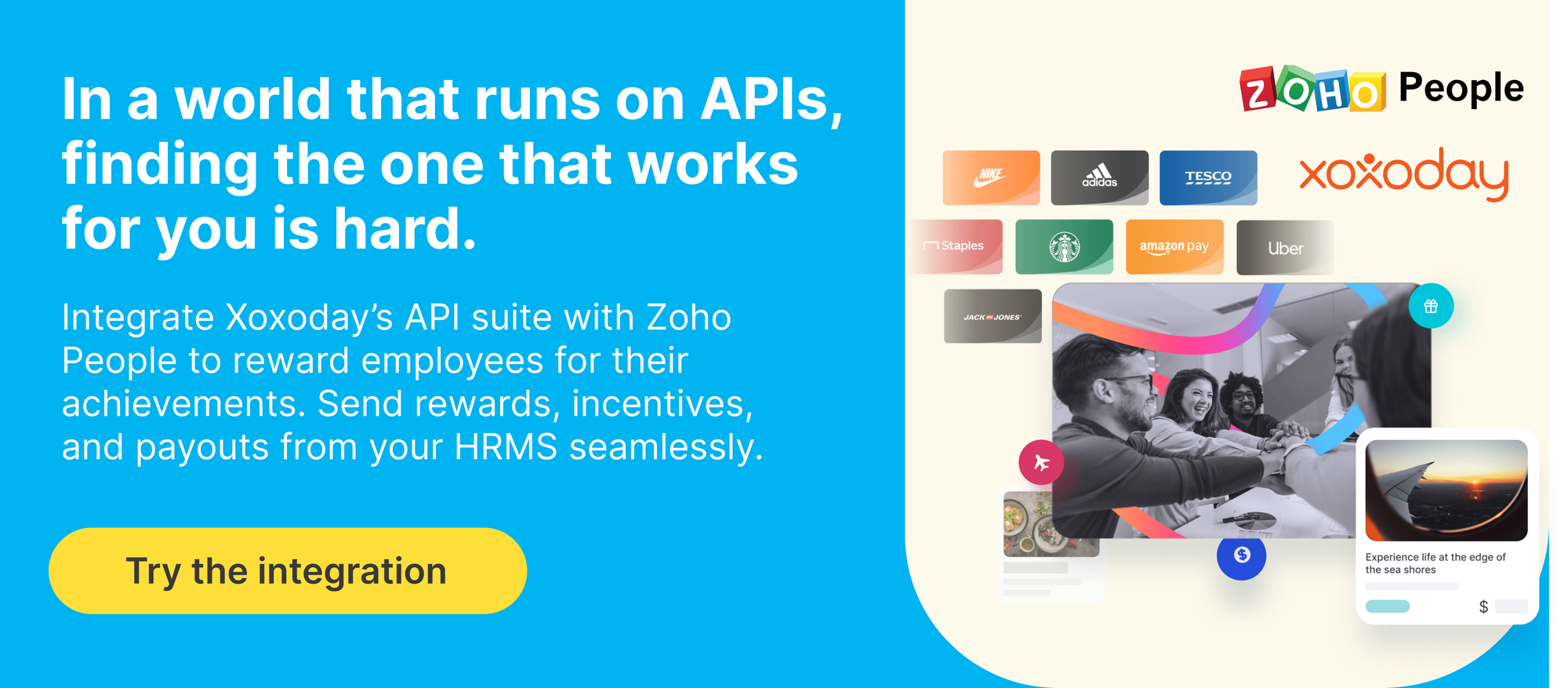
باختصار
من التسلسل الهرمي لأبراهام ماسلو للاحتياجات إلى الهجوم الحديث على نفسية الموظفين ، يظهر شيء واحد بوضوح: الموظفون لا يعملون لمجرد الشعور بمحفظة الثقل في تاريخ 1st من كل شهر.
يجب أن يشعر الموظفون بالتقدير والاحترام ، والأهم من ذلك ، يجب أن يكون هناك تيار خفي ناعم من الإحساس بالهدف في وجههم العام. إنه لا يسمح لهم فقط بالدفن في عملهم بسعادة ، بل ينبت فيهم غصنا ناشئا من الابتكار - مما يجعل المنظمة تزدهر ، وليس فقط البقاء على قيد الحياة. وهذا هو المكان الذي تصل فيه المجزية في الوقت المناسب ، والتي تضم خيارات انتقائية للاختيار من بينها ، مثل المذنب.
على الرغم من أنها قد تكون مشوبة بالمفاهيم الخاطئة - المكافأة مكلفة ، ولديها عائد استثمار غير موثوق به - فإن تأثيرها المثبت على رفع الروح المعنوية للموظفين وبالتالي على المحصلة النهائية للمؤسسة يجعلها شيئا لا بد منه. من أجل التنفيذ الفعال للمكافآت ، تحتاج الشركات إلى فهم ما يلزم لبناء برنامج مكافآت جيد والتحقق من فعاليته.
هذه المدونة ، بنظرتك المنتظمة والدورية إليها ، ستثبت أنها قاذفتك في هذا السياق.













